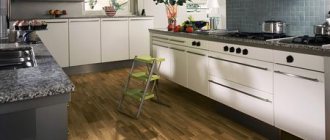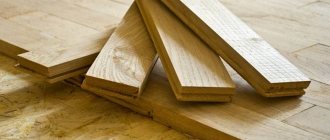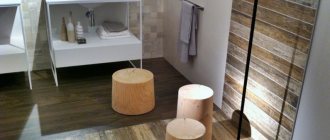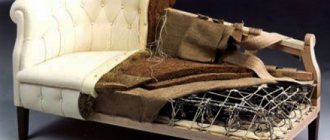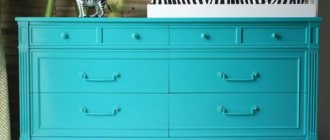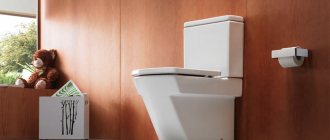- Do-it-yourself parquet repair and restoration
- Basic types of do-it-yourself parquet restoration
- The main reasons why parquet floors lose their appearance
- Preparing the premises for the main types of repair and restoration of parquet flooring
- Spot repair of old parquet: eliminating cracks and restoring loose boards
- How to get rid of squeaks and other problems that require restoration of old parquet
- What is the restoration of parquet after flooding?
- Features of parquet repair without sanding
- Repair and restoration of parquet: sanding, sanding, how these types of work differ
- What tool is used to restore and repair old parquet: sanding
- How sanding is carried out: the cost of repairing old parquet
- Video: repair and restoration of parquet
Do-it-yourself parquet repair and restoration
For a long time, parquet has been considered one of the most expensive materials for floor finishing, since natural wood is used for its production. Properly laid parquet looks aesthetically pleasing and attractive, and its service life is significantly longer than that of other coatings. The question often arises: how to keep parquet in perfect condition? Parquet repairs will not have to be carried out frequently if you constantly take care of the coating and eliminate them when defects appear.
If the installation of parquet was done correctly, then this coating can last for many years.
Types of repairs
With careful care of the coating, serious repairs can be avoided
Even such a high-quality and expensive coating as parquet requires regular maintenance and preventive restoration work.
Types of repair work:
- Planned repairs include regular elimination of even the smallest defects. In addition, parquet requires compliance with care recommendations and treatment with special products that extend its service life. Care products can be purchased at hardware and construction stores. Repairs are carried out if the coating has become dull, stains have formed, the dies have begun to creak, or the tightness of their abutment has been compromised. Sometimes it is necessary to remove a floor part for restoration or replacement.
- A major overhaul involves restoring or replacing a large section of pavement. It can be planned, to restore coating defects during long-term use, or unforeseen, when, due to some emergency, a large section of parquet has deteriorated.
If you want the coating to last for decades and at the same time have a beautiful appearance, you need to carry out scheduled repairs of the parquet floor with your own hands or with the involvement of specialists every 3-5 years.
Basic types of do-it-yourself parquet restoration
Before raising the issue of restoring parquet boards or parquet, you must first analyze the condition of the floor covering and, if specific problems are identified, make a decision on the need for repairs. To do this, you should think through the main stages of the work, approximately calculate the waste, so that during the repair process you do not encounter the problem of a lack of funds. Only after a preliminary assessment can work begin.
Before restoring the coating, it is necessary to assess its condition.
Depending on the degree of complexity of parquet repair and restoration, the work carried out can be divided into 3 types:
- Major renovation. It is carried out mainly after the expiration of the warranty period of the floor covering and in the event that the cost of restoring the parquet will be higher than the cost of a major replacement of the boards.
- Average renovation. It is planned when obvious defects have appeared on the floor that require elimination, for example, a change in the color of the surface, the appearance of stains, the mobility of some elements or squeaking when pressed. The work consists of replacing parquet or restoring individual tiles of the coating.
- Routine repair of parquet floors. This measure is more likely to be preventive; it allows you to postpone major repairs for a long time.
Note! Parquet is one of the most stable coatings. With proper operation and timely repairs and maintenance, it can last for several decades. Moreover, most of the restoration work can be performed locally.
Repairs of average complexity include general restoration of parquet or replacement of individual boards.
How to remove creaking parquet
The parquet creaks, what should I do? It’s no secret that in order to correct a defect, you need to find its cause and eliminate it; this is the only way to deal with the problem forever.
The main reason why creaking appears is the loose fit of the substrate: plywood or fiberboard to the concrete screed base. The second reason for squeaking is dried out parquet flooring. Therefore, eliminating parquet squeaks should begin with repairing the substrate.
How to get rid of squeaking if the substrate does not fit tightly
First, identify the areas of the floor where the creaking comes from; in these places it is necessary to disassemble the parquet. Dry the base with a hairdryer or fan; you can leave the parquet uncovered for several days to dry naturally.
After which, to eliminate squeaking, the substrate is drilled through so that the hole goes deeper into the concrete base by at least 50 mm. Next, dowel nails are driven in, and the plywood sheets are tightly pulled to the screed. When the base is secured, the dies can be installed in place.
It should be noted that this repair method is applicable even if it is necessary to eliminate the creaking of parquet without opening it. Holes are drilled through the body of the die, deepened into the concrete, and the coating is also attracted to the base using dowels. Then the repair areas are puttied and sanded flush. If the work is done carefully, after finishing, there is no creaking, and the repaired areas are almost invisible.
For a high-quality repair, so that the creaking does not recur, you should not just pull the plywood to the base, but it is advisable to also fill the voids between the layers. To do this, you need to make as many holes as possible, and through them, using a syringe with a soft tip, fill the gaps with glue, preferably a two-component polymer one. And then just tighten the backing tightly with dowels.
How to remove squeaking if the dies are dry
Despite all the advantages of parquet, wooden coverings have one significant drawback. The tree is hygroscopic, and is sensitive not only to humidity, but also to dry microclimates. The dies dry out and a squeak appears. In such cases, there are several repair options.
If the parquet is lying on concrete, glued with bitumen or glue, and creaking is observed in a small area, then in this area holes are made in the rivets along the entire length of the die, at a distance of 100-150 mm from each other, a drill diameter of 2 mm is suitable. Next, in order to get rid of the squeak, an adhesive solution, the composition of which depends on the base, is injected inside through these holes using a syringe and a soft needle. You can use a mixture of 1 part cement to 1 part water. If the dies are fixed to bitumen, then it is better to heat the bitumen to 150°C for repairs. A particularly strong connection will be achieved if you use modern adhesives.
Another method to eliminate squeaking is to use wax and solvent based lubricants. They are also injected between the die and the base under pressure using a syringe. If the squeak is in a very small area, then WD-40 is also suitable for repair. The can has a convenient long spout, so it is convenient to fill the voids between the parquet and the base.
Modern technologies for laying parquet imply that a plywood or chipboard backing is laid on a concrete base. In such cases, to prevent the floor from creaking, you can drill several holes in the die with a thin drill and tighten the rivets with self-tapping screws.
To get rid of a weak squeak, you can soak the parquet well with wax or mastic.
Tip: To prevent the screw heads from spoiling the appearance of the parquet, they need to be deepened, and then cover the hole with putty.
To repair panel parquet, the same methods are used as for repairing piece parquet, but holes must be made along the perimeter of the module and in the middle.
After rough floor repairs are completed, check the entire surface to make sure there are no squeaks. Be sure to place a heavy weight on the repaired areas to press the parquet more tightly to the substrate and increase the adhesion of the adhesive to the surfaces. After a day, you can remove the weight, check again whether the creaking has disappeared, and continue to restore the floor.
The main reasons why parquet floors lose their appearance
The need to repair and restore parquet will arise sooner or later in any case, and the main reason here is constant and long-term operation. After all, people not only walk on parquet flooring in house shoes, they also move furniture on it and damage the flooring with sharp heels or rough soles. Other causes of defects include:
- Constant excess humidity. Wood is distinguished by its ability to swell when wet, the same applies to wooden parquet blocks. If this is a basement floor and a special waterproofing layer is not laid under the parquet, then the coating will sooner or later swell and walking will be accompanied by squeaking.
- Excessively dry air. Constant high temperature in the room causes the wooden elements to dry out, which is likely to cause deformation and distortion of the base.
- Improper cleaning. Frequently carried out wet cleaning with a regular mop or steam cleaner leads to the accumulation and retention of liquid in the crevices, which can cause the wood to rot.
- No processing. If the purchased parquet has not been pre-treated with special agents that prevent the growth of fungus or wood pests, then such a floor will quickly become unusable, even with proper care.
Parquet flooring can deteriorate due to high humidity or excessive dryness in the room.
Among the main reasons why you will have to repair parquet boards is surface discoloration. This happens mainly due to the use of unsuitable detergents, excess moisture or the ingress of aggressive chemicals, such as ammonia. The main problems also include:
- Appearance of cracks. The main reason is considered to be dry air, which often occurs in winter with active use of heating devices. The preferred humidity in a room with parquet is 40-50%.
- Blistering of boards. It is formed due to the accumulation of water under the surface of the board or due to improper repair of the parquet after the room has been flooded.
- Lack of heat resistance. Associated with improper installation of insulation or poor processing of joints, and can also be caused by insufficient preparation of the base.
- Displacement of boards when walking. It occurs due to a violation of the screed technology, the absence of a soil layer or the formation of mold on the inside of the boards.
- Peeling of parquet from the base. The problem occurs when there are uneven surfaces on the floor, due to uneven application of the adhesive mixture, as well as when the dies are incorrectly attached to the wooden base.
- Gaps between boards. The main reason for the appearance is the use of too wet material.
- Glue protrusion. Occurs as a result of applying a very thick layer, improper laying of boards or due to incorrectly sized sheets.
- Scratches and dirt. This happens mainly when the floor covering is not used carefully.
The appearance of defects on the parquet may be the result of improper cleaning.
The most common problem that causes the need to replace parquet is subsidence of the floor, which occurs due to the destruction of the screed under heavy load.
How to repair parquet if cracks appear
Cracks usually appear if the dies have dried more than necessary, and as a result, a squeak also appears. And this happens if the air in the room is too dry. First of all, even before repairs, it is necessary to take care of humidifying the room, especially in winter, when heating dries out the air especially strongly.
Cracks not only spoil the aesthetics of the coating, but also contribute to the appearance of squeaking, so it is impossible to “turn a blind eye” to this defect. Repairing cracks begins, oddly enough, with the procedure of increasing the gaps. Using a knife or screwdriver, you should pick out the joint between the dies and drive a thin piece of wood, pre-lubricated with wood glue, into the gap. After drying, the protruding part of the patch is leveled with a plane into one plane and sanded flush with the parquet. Before finishing, be sure to jump on the repaired area to make sure there are no squeaks.
Preparing the premises for the main types of repair and restoration of parquet flooring
Any repair or restoration of parquet in an apartment should begin with preparing the room. To do this, you need to remove all furniture and interior items from the room. If you replace the boards locally, you can repair the parquet without removing the furniture, but in any case it is better to cover it with film to protect it from dust settling. During a major replacement, you should completely vacate the room, because any type of repair will be accompanied by dusty work, especially if you need to adjust the boards to size using a jigsaw.
It is also better to immediately identify all damage; you can even outline them with chalk so that during the repair process you do not miss defective areas. After assessing the condition of the coating, you should make sure that you have some tools, especially if you will be restoring the parquet yourself. These include:
- surface grinder or parquet sander;
- angle grinding;
- cycle;
- sandpaper with varying degrees of abrasiveness;
- vacuum cleaner;
- chisel and plane;
- jigsaw;
- putty for wooden structures;
- finishing coating, which includes varnish, wax or oil.
After assessing the condition of the parquet and determining the type of restoration, you need to stock up on all the necessary tools.
We should not forget about personal protective equipment, because some types of work should be carried out with gloves, and when using a jigsaw, it is recommended to cover your eyes with safety glasses.
Cost of parquet restoration
The main factor influencing the price of repairs and restoration work is the degree of damage to the parquet.
Companies and private craftsmen providing parquet repair services work according to three packages (tariff plans). The table shows approximate prices for parquet repair (restoration)
| Service package name | Repair cost, rub. | List of works | Condition of the parquet after repair |
| Economy package or Life package | 850 | Drum-type grinding, elimination of defects, application of one-component varnishes | Satisfactory |
| Standard package | 1000 | Sanding or grinding with a drum type machine. Repeated grinding with a surface grinder, elimination of defects, application of one-component varnishes | good |
| Premium package or elite package | 1250 | Sanding or grinding with a drum type machine. Repeated sanding with a surface grinder, elimination of defects, tinting, application of two-component varnishes | Excellent |
High-quality restoration of parquet can restore the floor covering to its beautiful appearance and restore its performance properties. And re-varnishing will allow the parquet floor to continue to delight its owners with its noble shine.
Spot repair of old parquet: eliminating cracks and restoring loose boards
The cost of parquet repair will primarily depend on the extent of the damage. Often, local replacement of some elements will cost a little less than a major overhaul, because it will be necessary to fit new parts to those already installed. The duration of operation of the floor covering without additional measures is influenced by the quality of local work.
The most common reason for minor parquet repairs is the appearance of cracks due to loosening of the planks. This problem is relevant due to the fact that wood is a capricious material, which is characterized by swelling and shrinking. Therefore, preventing the occurrence of cracks is considered a rather difficult task, since it is not always possible to maintain constant humidity and temperature in the room.
On a note! When large gaps appear, the first thing you need to do is pull the planks together and place a piece of wood in the free space, which will be enough to close the gap. If there are a lot of cracks, it is better to completely lift the covering and lay it again. You need to be prepared for the fact that some of the planks will need to be replaced.
Local restoration of parquet will cost much less than major repairs.
It is recommended to take into account that if, when loosened, only a certain number of planks are replaced, there is no guarantee that over time the same defect will not occur in another part of the floor. Step-by-step instructions for repairing parquet with your own hands:
- Using a chisel, remove any loose dies. If the element does not come out well, you can try to split the part with a sharp end by inserting a chisel parallel to the fiber structure. After splitting, the element is taken out in parts.
- Remove the remaining adhesive mixture and clean the base on which the removed boards were located.
- If strong unevenness occurs, use putty.
- Remove the side edges from the dies requiring replacement and level the ends using a plane.
- Sometimes, in order to install several strips, the parts adjacent to them are also replaced.
In some cases, when replacing several elements, the picture is assembled separately and then placed in its entirety in the resulting space. At the same time, it is necessary that the details match perfectly with the rest of the parquet in pattern and color and fit into the overall picture. When replacing individual parquet boards, you can use special glue or bitumen mastic, which requires heating before use.
Parquet blocks that are loose are removed using a chisel.
After a certain section of parquet has been replaced, a weight should be placed on top. In this case, it is necessary to additionally capture small areas located next to the long-glued elements. If there are glue residues on the sides of the edges, they must be removed immediately, because after drying it will be impossible to remove the glue without leaving traces.
When the boards adhere tightly to the base and the glue is completely dry, restoration work will need to be carried out. To do this, you need to clean the treated area with sandpaper, then remove the dust and cover the new parquet with varnish, oil, mastic, or the same composition that was used to treat the entire surface.
Materials for restoration
Most companies that produce floor coverings also produce special products for surface restoration. The range of these products is very wide; you can choose the best option for any type of damage, and it is not at all necessary that the brand of the repair composition matches the brand of the coating. All of them are easy to apply and, if the technology is followed, they can effectively eliminate defects without the slightest trace. As a rule, such compositions have a wide range of applications, so they can be used not only on parquet and parquet boards, but also on laminate, cork, and wooden furniture.
| Name | Characteristics |
Wax pencils | Pencils are made from a mixture of wax, colored pigments and modifying additives. The color palette includes the most popular wood shades - from white to dark brown. Purpose: repairing scratches, cracks and small chips on laminated surfaces (parquet boards, laminate, furniture). The composition is characterized by high adhesion to the surface being treated, does not crumble over time, and does not lose color. Shelf life is unlimited, consumption depends on the degree of damage |
Touch-up markers | The markers are filled with glazing and opaque compounds made from a mixture of organic pigments and a binder. Working rods have different thicknesses and can be sharpened at different angles. Using markers, you can eliminate microscratches and abrasions, as well as restore the texture of the coating after waxing. The retouching composition itself cannot fill in the depressions, so it is not suitable for repairing chips and ordinary scratches. Such markers are produced in a wide range of colors; shade selection is carried out using a color card |
Furniture touch | Thick tinted composition based on polymer dispersion. Designed to eliminate minor damage to laminated surfaces - chips, dents, scratches, abrasions. The color range includes all popular wood shades. It is applied with a brush, perfectly fills all the recesses, and dries quickly. To select an identical shade, it is recommended to mix several strokes together |
Hard wax | Colored wax in bars, which is applied in molten form. Designed to eliminate deep scratches, chips, dents and other defects. Suitable for floor coverings subject to high loads, does not peel off, does not crumble, does not fade. The color range includes more than 120 tones and shades. It is applied using a special tool - a wax melter; to obtain an identical shade, wax of several colors is mixed. After cooling, the strength of the composition is comparable to the strength of natural wood; the treated surface can be sanded, retouched, or varnished |
Revitalizing paste | Repair composition for serious damage - deep cracks and scratches, severe dents, chips. It has a thick consistency and is applied using a spatula. The paste is available in a wide range of colors, so choosing the right shade will not be difficult. The pot life of the composition is 20 minutes, complete drying occurs in 12 hours. Restored areas can be easily sanded, retouched with a marker or varnished |
Fixing varnish | Acrylic or urethane-alkyd based varnish, transparent. Available in aerosol bottles and applied by spraying. The composition is intended for partial varnishing of coatings after restoration, protecting the restored areas from contamination and abrasion. As a rule, such varnishes are non-halo, that is, after spraying, no halos remain on the surface around the treated areas. The product can have 4 levels of gloss: gloss, matte, silky-glossy and silky-matte |
Repair kit | The basic package includes wax bars in 7 shades, a retouching marker, a wax melter, a spatula and a cleaning brush, and napkins. From different manufacturers, such repair kits can be supplemented with replacement refills for markers, a spare gas cartridge for the wax melter, fixing varnish, and a color card. Large sets contain hard and soft wax, as well as markers in several shades |
These products are presented in a wide range in every hardware store. They can be purchased separately or as a set, taking into account the degree of damage to the parquet board. You can also buy tools for restoration work separately:
- plastic smooth spatula;
- spatula with grater;
- chisel;
- wax melter (gas or battery-powered);
- sanding discs made of special fiber.
Cordless wax melter
Grinding wheel
How to get rid of squeaks and other problems that require restoration of old parquet
The problem of a creaking floor is familiar to many, because it is considered one of the most common; it arises due to the friction of the planks relative to each other under the influence of weight. In this case, you can try to repair the parquet yourself using any type of fastener. These can be screws, self-tapping screws or other options screwed flush with the coating. After screwing in the element, the installation site is hidden using putty of the desired color.
Another reason for unpleasant sounds is the separation of the floor covering from the base. Here, an important task is to return the boards to their original position.
In some cases, in order to eliminate the squeak, you will have to completely or partially remove the parquet.
To repair creaking parquet flooring you may need:
- self-tapping screws, with the help of which individual strips are tightened to the base;
- an adhesive mixture injected into the gap between the slats using a syringe or syringe with a thin plastic tip;
- Polyurethane foam, due to its strong swelling, is recommended for use least often.
The most expensive parquet repair will involve complete or partial dismantling of the planks, after which they are re-installed, and the most unsuitable parts are either adjusted or replaced with new ones.
The third reason for the friction of the boards against each other is considered to be a violation of the technique of laying the dies and an incorrectly calculated distance between them. In this case, local repairs of the parquet are not allowed, because in any case it will be necessary to completely remove all elements, as well as move the logs, after which the coating will be laid again.
On a note! If one joist moves during assembly, do not lift the entire parquet completely. It is necessary to disassemble the adjacent part of the covering, use a hammer to knock the joist into place, and then reinstall the parquet.
If some parquet tiles have peeled off, you can fix the problem using self-tapping screws and a screwdriver.
In addition to the reasons listed, creaking sounds can also be caused by the absence of an expansion joint, which should be located between the edge of the parquet and the wall. In order to properly make a seam, after laying it is necessary to cut off part of the covering to form a small gap, the optimal size of which is 1-1.5 cm. There are other reasons why it may be necessary to repair panel parquet or conventional plank covering.
The appearance of a difference between shields or individual elements. In this case, it is necessary to sort out a significant area, because the cause of the violation may be deformation of the base. If a step of small height has formed, you can try to raise the protruding planks, cut off part of the coating at the base, or sand it.
Darkening of the surface. The main reason why old parquet has to be restored is considered to be the contact of aggressive chemicals on the surface, which quickly penetrate deep into the wood. Another reason is the wrong type of tinting or other coating. In this case, the only option for parquet repair is scraping and sanding, after which varnish, tonic or an oil-wax mixture is applied.
“Complicated cases” of restoration of old parquet
There are several situations in which it makes no sense to undertake parquet restoration yourself - you will only waste time and effort . Here are the most common ones:
- The parquet is very worn and has numerous defects and cracks. In this case, a complete replacement may not be necessary, but scraping is certainly not necessary;
- The parquet “swollen” after being heavily flooded with water. Since in this case some planks have probably come off the base, it will be necessary to re-lay the parquet (and possibly replace some elements), after which, again, resort to the procedure of scraping the old parquet;
- Over time, the parquet board has become dark and loose (it can be easily pierced with an awl). This is perhaps the most “sad” option, since in this case even sanding will not help the matter - a complete replacement of the parquet is necessary.
Sometimes a complete replacement of the parquet is necessary.
In other cases, it is quite possible to restore the parquet yourself; you just need to be patient and familiarize yourself with the basic restoration technologies.
What is the restoration of parquet after flooding?
Exposure to large amounts of water on parquet is considered one of the destructive factors, because wood is a natural material, and moisture almost instantly enters the pores and microcracks. As a result of flooding, the boards not only swell, but also lose their shape and their structure is disrupted. In addition, other problems arise:
If the parquet is flooded, you need to quickly remove the liquid and dry the coating, for example, with a hairdryer.
- blackening of the coating;
- development of fungus and mold;
- formation of cracks, differences or chips;
- warping and swelling;
- change in color of seams and joints.
To avoid having to carry out a major overhaul of the entire floor covering, you should try to remove and saturate all moisture as quickly as possible, using fans, heat guns or any other methods. In this case, the cost of repairing parquet after flooding will directly depend on the wet area, as well as on what kind of base was used to lay the covering.
If local swelling occurs, you can try to dry the area with a regular hairdryer, which will melt the mastic. The appearance of the smell of mastic indicates that you can try to return the parquet to its original place, after which you need to evenly distribute the load not only over the restored area, but also grab at least a meter on each side.
Note! In a situation where minor flooding has occurred, but the water has spread over the entire floor area, everything will depend on the speed of response. If you immediately begin to dry the surface and get rid of moisture, there is a high probability that swelling and re-laying of the floor will be avoided. If the floor was seriously flooded, major repairs cannot be avoided.
The consequence of the flood may be the appearance of mold and mildew, as well as a change in the color of the coating.
If, as a result of flooding and soaking, the planks have become detached from the base, you should immediately prepare to replace the covering with a new one. If individual dies that remain firmly attached to the surface are deformed, you can try to carry out restoration work.
When repairing parquet (consumer reviews contain such information), you can encounter situations where, after pouring, the parquet dries on its own in 3-7 days, takes on its previous appearance, and the planks take their original position. Therefore, you should not immediately begin major repairs. In any case, if you make a complete replacement, it is quite possible to wait a few days.
If the parquet boards have dried well, but still do not take their place or remain swollen, you will need to perform a complete overlap. After replacing the damaged area, the parquet is sanded using a sanding machine, after which the damaged area is sanded and re-varnished. You also need to take into account that even if a little more than 30% of the floor covering has been damaged, experts will still recommend performing a complete covering. In some cases, the cost of repairing parquet per m2 of damaged area may be higher than the cost of laying new parquet per square meter.
The parquet is swollen, how to repair it
Water is the main enemy of parquet floors. Whether it’s just dampness or the apartment is flooded, the wooden covering swells, bulges and undermines. Sushi is not sushi, but it will warp the wood. It is possible to repair such a floor if the damaged areas are minor.
Restoring parquet if the entire surface is simply dry, deformed, creaks, but has not peeled off from the base, is possible. You will have to pick out the warped rivets and replace them with new ones. Next, the parquet is scraped, the cracks are covered with putty, the surface is sanded and varnished.
If the tiles are swollen and detached from the base, then it is better to remove the entire parquet, select undeformed elements, buy the same new ones, and re-lay the flooring.
Tip: If you cannot find parquet that is the same or similar in appearance, then it is better to purchase dies from the same wood, or a different texture, but of the same size. Parquet restoration will be ideal if the difference between the tiles is hidden under a layer of darker stain or colored oil.
Features of parquet repair without sanding
After laying parquet or parquet boards, scratches are inevitable, because the floor is constantly damaged by shoes, furniture legs, animal claws, as a result of children's games or when heavy objects fall onto the surface. In some cases, you can try to restore the parquet without sanding, using a retouching pencil or putty that matches the color of the main coating. If the area is small, you can do without sanding and using varnish.
If the defect is minor, you can use a special putty or pencil.
Damage and scratches from the boards are removed using cosmetic putty, which is applied using an ordinary thin spatula. Finding the right color is not difficult, because retail establishments offer a wide selection of materials.
On a note! The second name for parquet putty is restoration paste. If you can’t find the desired option on store shelves, you can try making the paste yourself.
To make decorative putty, you need to mix crushed sawdust and epoxy varnish in a ratio of 1:4. After this, the required amount of dye is added to the mixture. The finished paste is applied to the damaged area, which is then treated with fine sandpaper.
Sometimes, after restoring oak parquet, in order to create a complete picture, it will be necessary to imitate joints in some areas using an ordinary awl and a metal ruler. Work should be carried out when the restoration paste is partially dry; it should not be very hard, but it should not stretch. Step-by-step instructions for repairing parquet with your own hands:
Cosmetic putty is applied to the damaged area using a spatula.
- Using a ruler applied at the end, make a small indentation at the joint.
- Using an awl, apply the end false joints along the attached ruler.
The final stage of such a restoration is considered to be varnishing the parquet. It is appropriate to use any type of varnish here: alkyd, epoxy, acrylic or water-based. Before using the composition, it is recommended to study the application features specified in the instructions. You also need to take into account that to obtain a perfectly smooth surface you will need to apply at least 2-3 layers of varnish. After the varnish has completely dried, to obtain a better result, it is recommended to rub the surface with mastic, after which the restoration of the old parquet with your own hands without sanding is considered complete.
↑ If the parquet looks dull
Let's start with the most common problems. Dull color is the inevitable result of improper care or complete lack of care. But everything is as simple as shelling pears - give preference to shoes with soft soles, put special pads on furniture legs, which are sold in any hardware store, and don’t be lazy to rub the floor with mastic. These simple events will help maintain shine and presentable appearance.
Now let’s talk about what to do if it was still not possible to preserve the beauty. Restoring parquet involves sanding and sanding, followed by the application of a new decorative coating.
It is important! It is not recommended to apply varnish immediately. Mix it thoroughly and leave for 10 minutes to remove any air bubbles.
Varnishing parquet flooring is a simple procedure, but requires compliance with certain rules. It is better to apply the varnish with a foam roller or a wide brush. They work with a tool without the use of force: light, smooth movements are made in the direction of the wood structure. Varnish is usually applied in several layers - each new layer not only increases the strength characteristics, but also improves the color of the floor covering.
It is more convenient to apply the varnish with a roller
The following must be taken into account: the varnish dries quite quickly (a couple of hours is enough), but the floor can be subjected to stress only after 5 days. It will take at least 7 days for final drying. Please note that high humidity and low room temperature significantly slow down this process.
Repair and restoration of parquet: sanding, sanding, how these types of work differ
Sanding is the process of leveling the surface of the floor covering by removing the worn layer from the parquet using a cutting tool. By grinding we mean almost the same process, only in this case the surface layer is removed by using an abrasive material.
Today, the processes are considered almost identical, which is due to the frequent use of machine scraping, which requires the use of an abrasive material. Parquet repair (grinding or sanding) is carried out using various equipment, the selection of which takes into account the following factors:
Using scraping, the top old and damaged layer of the coating is removed.
- Scale of work. Sanding and restoration of parquet are carried out if it is necessary to process a small area and are mainly carried out using hand tools. If you need to organize work over a large area, it is better to use a grinder.
- The original state of the parquet before renovation. If the coating is in a disrepair, repairing the floor yourself using hand tools will be quite time-consuming, but a sander will help to significantly reduce not only time, but also labor costs.
- Performer experience. Parquet repair (scraping) is often performed by people who do not have much experience working with sanding machines. Professional craftsmen rarely use hand tools during the repair process.
On a note! If you want to repair the old parquet flooring in your apartment faster with your own hands, you don’t have to immediately buy a sanding machine, because it is not only expensive, but also quite expensive to maintain. The best option in this case is to rent the device for the duration of the repair work.
For grinding, devices with abrasive materials are used.
Caring for parquet after renovation
Restored parquet flooring puts forward some requirements for compliance with operating rules:
- ensuring optimal humidity levels;
- eliminating prolonged exposure to ultraviolet radiation on wooden flooring;
- preventing abrasive particles from getting onto the parquet. The main enemy of parquet is: sand, legs of furniture, chairs and chair wheels.
A door mat, felt pads on the legs of furniture and chairs, a pad for a computer chair, indoor slippers instead of outdoor shoes - these are simple ways to protect the parquet from destruction.
In addition, wet cleaning of parquet is carried out exclusively by hand using special detergents.
What tool is used to restore and repair old parquet: sanding
The main tool for manual scraping is considered to be a scraper, the task of which is to scrape, rather than plan, a wooden covering. The device itself is a simple design and consists of a metal plate sharpened at an angle with a fixed handle.
Main technical characteristics of the device:
- Blade thickness. It is selected based on the height of the coating, taking into account the applied paint layer. A blade with a thickness of 0.7-0.8 mm is considered optimal; in this case, the size of the peeled layer should not exceed a few millimeters.
- Blade width. The wider the base, the larger the layer you can remove in one pass. Experts recommend purchasing a tool whose width does not exceed 45 mm; If the blade is wider, the scraper will be difficult to work with.
- Handle length and material. It is more convenient to control the pressure if the tool has a short handle. Recommended length – 45 mm. The material is chosen based on personal preferences, but still many note that when working with a wooden handle, the hand sweats less than after working with a plastic one.
Manual scraping of parquet is carried out using a special tool - a scraper.
Additionally, for ease of use, many product options are equipped with a pressure handle, which allows you to increase the pressure on the working tool. Separately, we should highlight the figured cycle used in the repair of block parquet to decorate the figured wooden plinth. The estimated cost of the device, depending on the characteristics, varies from 100 to 200 rubles. If a blade breaks during operation, it can be easily replaced by purchasing a new one. At the same time, the price of blades ranges from 30 to 50 rubles.
The main advantages of using cycles:
- low cost of the device;
- the ability to carry out repairs in hard-to-reach places;
- maintaining the appearance of the coating;
- absence of dust during operation.
It should be noted that when repairing artistic parquet, the use of cycles makes it easy to carry out actions, observing the correct direction of the wood fibers.
In addition to the advantages, there are also some disadvantages:
- time-consuming work;
- removing a fairly thick layer of coating;
- the need to exert a large amount of physical effort;
- working in an awkward position.
Work is done much faster and easier using a sanding machine.
Floors
26 votes
+
Vote for!
—
Vote against!
Among various floor coverings, parquet occupies a special place. This flooring is famous for its natural beauty and uniqueness. Unfortunately, like any other material, parquet wears out and becomes damaged over time, losing its attractiveness. Complete replacement of this floor covering is fraught with large labor and financial costs. But thanks to the possibility of repeated processing of wood, restoration of parquet is possible. Such work requires certain skills and experience. But for those who know how to use tools and like to do everything themselves, restoration of parquet with their own hands is also possible.
- Tools and materials
- Restoring the parquet surface
- Restoring parquet color
- Removing scratches
- Repairing potholes and chips
- Restoring damaged parquet planks
- Eliminating cracks
- Eliminating squeaks in parquet floors
- Elimination of bloating
- Restoration of damaged and peeling parquet planks
- Parquet restoration video tutorial
Depending on the nature of the damage, restoration of old parquet is divided into two categories. The first is surface restoration. The second is the restoration of parquet blocks. Comparing these types of work, the complexity of their implementation becomes obvious. Thus, the restoration of dies is an order of magnitude more difficult and requires more effort, in contrast to the restoration of the surface. Therefore, when planning to do this work yourself for the first time, you need to understand that it may not work out the first time. In this case, it is better to contact professional parquet floorers. But it should immediately be noted that parquet restoration work is rated quite highly. Of course, when deciding how much it costs to restore parquet, everything depends on the nature of the damage and the amount of work being done. If you decide to restore parquet flooring yourself, you will have to be patient, as this work is very labor-intensive.
Tools and materials
To perform parquet restoration work, you will need certain materials and professional tools, which you can buy, but their price is quite high. Do-it-yourself parquet restoration work is rarely done, and the tool itself will gather dust in the closet all this time. Therefore, it would be more practical to rent it. of tools used is given below:
- scraping machine or regular scraper;
- sanding machine and a set of sanding cloths of various grain sizes;
- industrial vacuum cleaner;
- chisel and hammer;
- drill and hacksaw;
- wide and narrow spatulas;
- roller or brushes;
- soft shoes, respirators and safety glasses.
To restore parquet, you will need the following materials:
- parquet tiles to replace severely damaged ones;
- putty;
- parquet glue;
- varnish or mastic;
- stain or oils.
Having acquired everything you need, you can begin the restoration work itself, which boils down to restoring the surface and replacing or repairing the parquet planks themselves. This division is due to the complexity, labor intensity and cost of the work. So, for surface restoration of parquet, the cost will be about 10 – 15 USD. per m2, and the volume of work itself is less.
Restoring the parquet surface
Restoring the parquet surface involves restoring the color of the wood, eliminating scratches, chips, gouges and unevenness of the parquet. When performing surface restoration, it is not necessary to dismantle all or part of the coating.
Restoring parquet color
Over time and aggressive environments, wood darkens and loses its attractiveness. Therefore, it is necessary to restore the color of the parquet from time to time. This procedure is the simplest and does not require much effort. To restore the color of parquet you will need to do the following:
- First we remove the baseboard;
- Using a scraper or grinding machine, remove the layer of old varnish. For hard-to-reach places, angle grinders are used. Also, removing the varnish coating is done using an industrial hair dryer, which heats the varnish and then removes it using a spatula;
- after cleaning the varnish, thoroughly vacuum the surface and inspect it for other damage;
- If necessary, putty the surface. If you want to change the color, you can use stain;
- if everything is in order, then we take the sander again and sand the parquet with a fine-grain emery cloth. The task is to eliminate large roughness of parquet flooring and clean its surface from darkened areas;
Important! When performing parquet restoration work, you should wear soft shoes with shoe covers over them. When cleaning the parquet surface with a machine, there will be a lot of dust, so it is a good idea to protect your eyes and respiratory tract.
- Upon completion of the final sanding, we take a vacuum cleaner and thoroughly remove any remaining dust. It is necessary to achieve perfect cleanliness;
- After the parquet surface has been thoroughly vacuumed, the first primer coat of varnish can be applied. This is done with a brush or roller. After it has dried, the surface is carefully sanded again, but with zero sandpaper, and the next layer is applied. After each layer has completely dried, the sanding procedure is repeated. There can be up to nine layers of varnish in total. Toning and varnishing of parquet is carried out in the direction of the wood grain. Instead of varnish, the parquet can be covered with mastic;
- After applying the last layer of varnish, the parquet is left to dry for at least three days. In this case, the windows in the room should be closed and there should be no drafts. The temperature should be between 17 – 22 °C, and humidity 40 – 70%.
Removing scratches
Among the most common damage to the parquet surface are scratches. They appear quite easily when moving furniture. After this, the parquet can be restored in several ways:
- if the scratches on the parquet are small, not too deep and wide, then restoration of the damaged areas can be carried out using repair kits for parquet or, for example, using wax pencils. This approach will save time and effort;
- but in the case of deep and wide scratches, everything is much more complicated. To restore parquet with such damage, complete removal of varnish will be required. To do this, use the method described above to clean the parquet from the varnish coating;
- Next, using a scraping machine, remove a small layer of parquet. The idea is to remove the damaged layer of wood. Carrying out scraping correctly for the first time without any work experience is quite a difficult task. Therefore, you need to be prepared for the fact that you will have to scrape the floor several times before you get a decent result;
- after scraping, the room is thoroughly cleaned and vacuumed;
- further work consists of priming, puttying and varnishing the parquet.
Repairing potholes and chips
Despite the fact that hardwood is used for parquet flooring, the wood is not able to withstand a strong blow from an object made of a material of higher density. As a result, potholes, chips and unevenness appear. Restoration of the parquet surface with such damage is as follows:
- the first thing we do is remove the old varnish and inspect any existing damage;
- then we begin scraping the surface. We remove a small layer of wood, thereby leveling and eliminating potholes and irregularities. If after the first sanding a strong difference in the shade of the parquet is noticeable, then we perform the sanding again;
- Now that the main irregularities have been eliminated, we begin to eliminate chips. They are compared using ordinary putty. In order for the surface to look the same after puttying, fine dust is added to the putty after sanding. The resulting mixture is leveled over the surface of the parquet with a wide spatula;
- After the putty has dried, we begin sanding the parquet and varnishing it.
Restoring damaged parquet planks
Unlike restoring surface damage, restoring parquet flooring with cracks, swelling, squeaking or loose parquet flooring will require more effort, time and skill. In such cases, it is quite difficult to repair parquet, and therefore many people prefer to turn to experienced craftsmen. It should be immediately noted that with such damage, the price for restoration of parquet will be about 15 - 20 USD per m2. Which, together with the necessary materials, can result in a very round sum.
Eliminating cracks
Wood, due to its structure, absorbs and releases moisture quite easily. This fact, combined with a violation of the parquet laying technology and water entering the surface, leads to the appearance of cracks. To eliminate this type of damage, you must do the following:
- remove the baseboards and clean the surface of old varnish using a scraper or sander;
- then the surface of the parquet is scraped to remove the top damaged layer of wood;
- Upon completion of sanding, thoroughly vacuum the parquet;
- Having inspected the surface for cracks, we clean them of excess debris inside. To do this, we use a vacuum cleaner and a knife with a thin blade. Carefully clean off the dirt, trying not to damage the edges of the parquet flooring;
- Now we take the putty and add dust or small shavings to it after sanding the parquet. Apply the resulting mixture to the parquet and use a spatula to fill all the cracks. Dust from old parquet will equalize the color tone of the parquet and putty;
- after the putty has dried, the parquet is sanded several times and covered with a primer layer of varnish;
- Let the varnish dry, sand again and apply the next layers of varnish.
Eliminating squeaks in parquet floors
The appearance of squeaks in parquet flooring can be due to several reasons. These could be loose planks, sagging spacer wedges, or voids under the parquet itself. Eliminating parquet squeaks does not require complete removal of varnish, scraping and sanding. It is enough to do the following:
- Remove the skirting boards and check the spacer wedges. It may be that they have simply dried out over time and no longer fulfill their role and do not hold the parquet floors together. In this case, we take out the old wedges and drive new ones in their place. It should be noted that this procedure is best performed at a relative room humidity of about 40%. Having installed the baseboards in place, we monitor the parquet throughout the week. If the squeaks remain, then the reason may be different;
- If the spacer wedges are in order, then we will localize the creaking parquet floors. Typically, parquet is laid on a plywood base or directly on a concrete base. Over time, concrete and plywood wear out and sinkholes appear. It is in these places that the parquet creaks. Eliminating the squeak is quite simple. A small hole is drilled in the creaking strip. Either parquet glue or concrete solution is pumped into it using a syringe. As soon as the repair compound stops being absorbed and remains in the hole, we stop pumping and leave the parquet under pressure for a couple of days. Upon completion, the hole is filled with putty or a pin is inserted;
- If the creaking of the parquet has a fairly large area and it is impossible to eliminate it using the methods described above, you will have to re-cover the entire coating. In this case, you need to be prepared for a full restoration. Starting from removing varnish and ending with re-laying the parquet.
Elimination of bloating
Swelling of parquet is one of the most unpleasant damages, the appearance of which indicates a violation of the installation and operation technology. Such damage to parquet is quite difficult to correct, especially if panel parquet restoration is carried out with such a diagnosis. It is impossible to repair such damage with your own hands without completely re-flooring the parquet. The reason for swelling is quite simple - increased humidity. To eliminate swelling, you need to do the following:
- if the damage area is small, then use a conventional or industrial hair dryer to warm up the parquet;
- after the smell of glue or mastic appears on the surface of the parquet, place a load of at least 10 kg/dm2 and leave it for a day;
- We check it a day later. If swelling has decreased, the procedure should be repeated.
Another reason for the appearance of swelling may be the lack of hydraulic compensation gaps near the walls. In this case, you should completely disassemble the parquet, allow the parquet and the base to dry naturally and then re-lay it.
Restoration of damaged and peeling parquet planks
Parquet strips that are damaged or have come loose from the base are quite common. This can be seen especially often when old parquet flooring is being restored. In such cases, the damaged planks are replaced with further restoration of the entire surface. To do this you need to do the following:
- remove old varnish and identify loose parquet flooring;
- if the plank is very dry, there is a gap of 5 mm or more between it and adjacent planks, then it should be replaced;
- if the gaps are small, then pump glue under the bar and leave it under pressure overnight;
- To replace damaged parquet strips, you will need a chisel and a hammer. With their help, we split the bar in the middle and remove the remains;
- Using a narrow spatula, remove the remnants of old glue;
- Now you need to adjust the new bar to the required size. We also cut off the protruding spike;
- Apply glue to the base in the cleaned space. Then we place the bar at an angle so that its groove fits onto the tenon lying next to it, and then press it tightly to the base;
- after gluing the strip, leave it under pressure for a day;
- Finally, the surface of the parquet is puttied, sanded and covered with varnish or mastic.
Restoring parquet with your own hands is a completely feasible task for those who know how to handle tools. But lack of experience in working with parquet can ruin all your efforts. Therefore, before starting restoration on your own, it will not be superfluous to have a little training or participate in parquet repair with experienced craftsmen.
Parquet restoration video tutorial:
How sanding is carried out: the cost of repairing old parquet
As for grinding, you can use a variety of abrasives. Sandpaper is considered the simplest. Of course, doing the work manually is quite long and difficult. To speed up the restoration, some people attach sandpaper to the base of the shoe, but this method is not widely used due to the fact that it is difficult to control the work of the legs and maintain the same pressure.
A more advanced repair option is the use of a drum-type sander. The device is mainly used for deep sanding, because coarse abrasive cannot leave behind a perfectly smooth wooden floor. In one pass, the machine removes 1.5-2 mm of coating. To prevent dust generated as a result of removing the coating from spreading throughout the room, the device is additionally equipped with a dust collector. The most popular model of parquet sanding machine is considered to be SO-206, the price of which varies from 56 to 70 thousand rubles.
During the process of both grinding and sanding, scratches may appear when large abrasive grains leave marks. This is especially noticeable on soft types of wood, such as pine. In this case, you can re-grind or cover the damaged areas with restoration paste. After completing all restoration work, you need to apply a protective varnish coating, which not only makes the parquet attractive, but also protects the surface from mechanical damage.
A drum sander is best suited for sanding parquet.
On a note! It is recommended to repeat floor polishing at least once a year. The more layers, the stronger the coating. All work on applying the varnish layer must be carried out in a respirator.
As for the price of restoring old parquet, it directly depends on the original condition of the coating. If the parquet is in satisfactory condition and you only need to go over it with a sander and also restore the varnish layer, then the cost will be about 850 rubles/m². When you want to make the floor covering perfect, you need to carry out a variety of work: sanding and sanding with a drum machine, re-sanding with a surface grinder, tinting and applying varnish. Such work will not cost less than 1250 rubles/m².
Parquet is an expensive floor covering that has long been admired. Even the cheapest parquet option will always look better and last longer than the most expensive laminate. In order not to have to carry out major repairs of parquet, it is recommended to carry out restoration and restoration work from time to time, which can extend the life of the material. Even a simple application of an additional layer of varnish will help refresh the parquet and restore its shine.
Removing old floors: secrets of successful renovation (read more)
How to remove scratches on parquet
Scratches on hardwood floors are the most common type of wear. But scratches are different, so we’ll consider each repair option.
To repair minor defects, scratches should be covered and the surface sanded.
Single minor defects
Small, not very deep, single scratches can be repaired with a special marker or wax, which can be easily purchased at any furniture or carpentry store. To prevent the repair from being visible, carefully choose the color of the putty; it is better if it is a little lighter.
Cover the perimeter of the scratch with masking tape, and move it over it several times with a wax crayon or a brush with putty. Wait until it dries and repeat the procedure. When the second layer dries, rub the surface with a soft fleecy cloth and remove the tape.
If the entire parquet is damaged by small scratches
If there is a thick layer of varnish on the floor, but the scratches are small, then the question of how to renew the parquet is solved as follows: it is most advisable to remove the thin damaged layer. To do this, the entire surface is processed with a rotary orbital grinding machine with abrasive No. 180, 320, then No. 800, 1200. Next, the floor is polished with paste to the desired shine. As a rule, after such repairs, the parquet looks like new.
Tip: To renew parquet, it is better to sand with an orbital machine with a fine step, for example 2.2, at medium speed. And it should be polished with a special machine. For better results, you should purchase foam attachments of different hardness and paste No. 1 and No. 2. First, the parquet is polished with a harder (orange) sponge at medium speed; each square meter of the sponge must be thoroughly washed in a warm soapy solution. The final polishing is done with a soft (black) sponge at high machine speeds.
Repairing deep scratches
To repair deep scratches, you must first pick them out in a V-shape and deepen them a little. Before removing scratches on the parquet, they are degreased and then covered with putty. When the composition has dried, the repair areas are carefully sanded and tinted.
Sanding machines will help with minor repairs
When repairs can only be performed by specialists
In some cases, restoring a parquet floor will require the involvement of professionals with experience in this field and professional equipment.
When it is difficult to eliminate defects yourself:
- Severely worn flooring with deformed boards and cracks can be restored without replacing the entire floor.
- If, after flooding, the dies are swollen and deformed, they must be removed and dried. Severely deformed elements must be replaced. After laying the floor, the old boards need to be sanded and varnished.
- The parquet has darkened, its strength has decreased, fungal infections have appeared, the wood can be pierced with an awl to 5 mm. Such a covering will have to be re-laid and the subfloor completely dried.
Related article: How to level the walls in the bathroom with your own hands
In other cases, you can perform the restoration yourself.
We check the condition of the board by pricking the dies at an angle of 45 degrees with a shoe awl. With a medium degree of pressure, the awl should pierce the surface of the oak board less than 5 mm; birch, walnut and ash - less than 7 mm.
If the tool goes deeper, then the floor element needs to be replaced.
